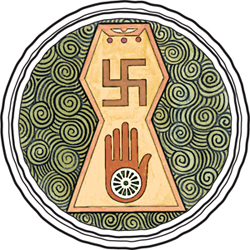Jainism
FOUNDED: The origins of Jainism are obscure, extending back before recorded history.§
FOUNDER: Rishabha, also known as Adinatha. §
MAJOR SCRIPTURES: The Jain Āgamas and Siddhāntas, based on the teachings of Vardhamana Mahavira (ca 500 BCE), among Jainism’s most influential teachers and the 24th and last in the lineage of tīrthaṅkaras.§
ADHERENTS: About six million, almost exclusively in Central and South India, especially in Mumbai.§
SECTS: There are two sects. The Digambara (“Sky-clad”) sect holds that a saint should own nothing, not even clothes, thus their practice of wearing only a loincloth. They believe that salvation in this birth is not possible for women. The Svetambara (“White-robed”) sect disagrees with these points.§
Jainism strives for the realization of the highest perfection of man, which in its original purity is free from all pain and the bondage of birth and death. The term Jain is derived from the Sanskrit jina, “conqueror,” and implies conquest over this bondage imposed by the phenomenal world. Jainism does not consider it necessary to recognize a God or any being higher than the perfect man. Souls are beginningless and endless, eternally individual. It classes souls into three broad categories: those that are not yet evolved; those in the process of evolution and those that are liberated, free from rebirth. Jainism has strong monastic-ascetic leanings, even for householders. Its supreme ideal is ahiṁsā, equal kindness and reverence for all life. The Jain Āgamas teach great reverence for all forms of life, strict codes of vegetarianism, asceticism, nonviolence even in self-defense, and opposition to war. Jainism is, above all, a religion of love and compassion. §
The primary goal of the Jains is becoming a Paramātman, a perfected soul. This is accomplished when all layers of karma, which is viewed as a substance, are removed, leading the soul to rise to the ceiling of the universe, from darkness to light, where, beyond the Gods and all currents of transmigration, the soul abides forever in the solitary bliss of moksha. Moksha is defined in Jainism as liberation, self-unity and integration, pure aloneness and endless calm, freedom from action and desire, freedom from karma and rebirth. Moksha is attainable in this world or at the time of death. When it is reached, man has fulfilled his destiny as the man-God. For the Jains there is no creator God and, therefore, no communion with Him. The nature of the soul is pure consciousness, power, bliss and omniscience.§
The soul passes through various stages of spiritual development, called guṇasthānas, progressive manifestations of the innate faculties of knowledge and power accompanied by decreasing sinfulness and increasing purity. Souls attain better births according to the amount of personal karma they are able to eliminate during life. Between births, souls dwell in one of the seven hells, the sixteen heavens or fourteen celestial regions. Liberated souls abide at the top of the universe. All Jains take five vows, but it is the monk who practices celibacy and poverty. Jainism places great stress on ahiṁsā, asceticism, yoga and monasticism as the means of attainment. Temple pūjās are performed to the twenty-four Tīrthankaras or spiritual preceptors, literally “ford-makers,” those who take others across the ocean of saṁsāra.§
- I believe in the spiritual lineage of the 24 Tīrthankaras (“ford-makers”) of whom the ascetic sage Mahāvīra was the last—that they should be revered and worshiped above all else.
- I believe in the sacredness of all life, that one must cease injury to sentient creatures, large and small, and that even unintentional killing creates karma.
- I believe that God is neither Creator, Father nor Friend. Such human conceptions are limited. All that may be said of Him is: He is.
- I believe that each man’s soul is eternal and individual and that each must conquer himself by his own efforts and subordinate the worldly to the heavenly in order to attain moksha, or release.
- I believe the conquest of oneself can only be achieved in ascetic discipline and strict religious observance, and that nonascetics and women will have their salvation in another life (Digambara sect).
- I believe that the principle governing the successions of life is karma, that our actions, both good and bad, bind us and that karma may only be consumed by purification, penance and austerity.
- I believe in the Jain Āgamas and Siddhāntas as the sacred scriptures that guide man’s moral and spiritual life.
- I believe in the Three Jewels: right knowledge, right faith and right conduct.
- I believe the ultimate goal of moksha is eternal release from saṁsāra, the “wheel of birth and death,” and the concomitant attainment of Supreme Knowledge.
